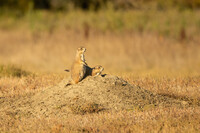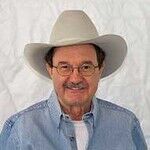When I headed to Montana to visit the American Prairie, I had bison on my mind. They are the quintessential plains animal and North America's largest land mammal. But what I didn't expect was for a rodent to pique my interest and steal my heart.
The black-tailed prairie dog lives in Montana and is the most abundant of the five prairie dog species. Even still, it has lost 95% of its historic habitat. This adorable critter plays an outsized and sometimes complicated role in life on the prairie.
Prairie dogs have long been considered an agricultural pest on working lands, and they have an extensive history of being the target of government-sponsored extermination efforts. American working lands are important: They grow our food. But as I sat at American Prairie's Antelope Creek Campground and watched a burrowing owl perched on top of a nearby prairie dog burrow, I couldn't help but wonder if there was a way we could do right by everyone.
It's why I wanted to talk to Defenders of Wildlife's senior field representative, Chamois Andersen, and American Prairie's director of rewilding, Dan Kinka, who has a Ph.D. in ecology. As it turns out, doing right by everyone is exactly what these conservationists have in mind.
Chamois comes from a Wyoming horse-ranching family, so she understands all too well the concerns of working lands in the Great Plains. Also, as an environmental scientist, she knows what prairie dogs bring to the land. "They just have that uncanny ability to manage the prairie for its ecosystem benefits for a host of other animals," she said, "and that includes the grasses and the underground burrows, and, of course, them being a prey item."
Enough animals rely on prairie dogs for food that they earned the nickname of "the chicken nugget of the prairie." One predator of note that depends on them as its sole food source is the endangered black-footed ferret. Other animals rely on prairie dogs for their burrows, such as burrowing owls, rabbits and prairie rattlesnakes.
Some ranchers worry that prairie dogs compete with their grazing livestock for forage. Prairie dogs clip the grasses short around their burrows to keep their line of sight clear. They spend a lot of their time keeping watch, trying not to be eaten. However, scientists have consistently shown that when prairie dogs trim the grass, it increases the grass's nutrition, which is beneficial for grazing animals.
It's a lot like mowing your lawn. When you cut your grass, it stimulates new growth for young, more tender, more nutritious shoots. The animals know it, too. "Bison prefer to graze on lands at Prairie Dog towns because of that relationship to the grasses," Chamoise said, "And prairie dogs love to build their towns where bison have roamed."
These prairie dog towns are even important to big game animals such as elk, bighorn sheep and pronghorn, which in turn benefit big game hunters.
American Prairie have a lot of elk on their preserve, and they manage an elk hunt on their Blue Ridge Special Management Area. Dan said, "The elk come down on the prairie dog colonies many times of the year and just feed on the new grasses that are coming up."
Even still, state Departments of Agriculture in four states list black-tailed prairie dogs as agricultural pests. This means landowners can poison, shoot or otherwise exterminate them, but not all of them do. "There are many ranchers that live with them day-to-day," Dan said, "and they realize they're not that hard on the landscape."
Some ranchers will also work with conservationists for more humane ways to manage prairie dogs on their property. One way is to translocate them to new prairie dog towns, but this requires a permit and isn't always possible. American Prairie must work under the guidelines of the Montana Department of Fish, Wildlife and Parks, which has the jurisdiction and authority over all wildlife, even species such as prairie dogs the state deems "pests." Conservationists cannot simply go on to private property and translocate prairie dogs without the proper permits.
It strikes me as odd that landowners can potentially poison or shoot prairie dogs more easily than conservationists can translocate them. This is where landowners and conservationists get innovative. Since prairie dogs have an aversion to tall grasses and shrubs, landowners can plan for that in their landscape. If prairie dogs can't see over it, they can't spot predators. So another way to prevent prairie dogs from encroaching into areas they're not wanted is to set up a temporary fence and let the vegetation grow. Once vegetation gets to a certain height, the fence comes out and prairie dogs won't touch it.
"The entire prairie dog colony is a really unique piece of habitat," Dan said. Since the American Prairie has specific areas on their preserve where they are working to bolster the prairie dog population, they also use the bio fence approach to be good neighbors. Conservationists want to keep prairie dogs on property where they are valued and not considered a nuisance.
Prairie dogs are only found in North America, and they deserve their place in the Great Plains conservation spotlight alongside the bison and the grizzly bear. These "pipsqueaks of the prairie" take care of one another along while also benefitting more than 100 other species. That's why I may have arrived in Montana dreaming about bison, but I left enamored with the black-tailed prairie dogs.


Do you know anyone who's doing cool things to make the world a better place? I want to know. Send me an email at [email protected]. Also, stay in the loop by signing up for her weekly newsletter at WriterBonnie.com. To find out more about Bonnie Jean Feldkamp and read features by other Creators Syndicate writers and cartoonists, visit the Creators Syndicate website at www.creators.com.






View Comments